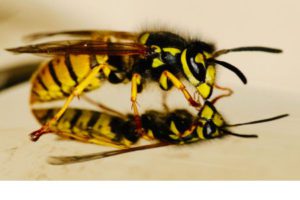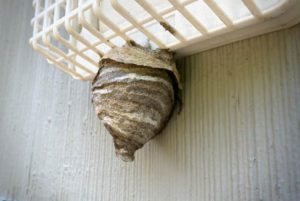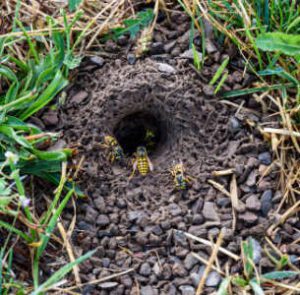PLAN TO ENJOY YOUR YARD WITHOUT STINGING INSECTS!
By Zachary Ciras on July 2, 2020.
We’re all pretty well resigned to a limited or stay-home vacation this summer. But we’re also determined to make the most of it – we’re going to take back our backyards! Because your family will be spending more time outside on the deck, in the pool, and working in the garden, you’re apt to notice insects that you didn’t even know were sharing your property.
We can coexist with, and maybe even appreciate, many of these seasonal visitors. Others…not so much. It’s hard to ignore the presence of yellowjackets and other wasps when they’re nesting in your yard.

Yellow Jacket photo by James Wainscoat via Unsplash.com/@tumbao1949
In our region, various flying, stinging insects (yellowjackets, paper wasps, European hornets, baldfaced hornets, bumble bees), are just getting their hives and colonies underway. Colonies will continue to grow and add new individuals until the first frost in the fall.
IT’S ALL ABOUT NEST LOCATION
The nests of some wasps, baldfaced hornets for example, are typically up in trees and rarely cause a problem. However, yellowjackets, our least favorite summer pests, tend to nest right where we don’t want them (see Yellowjacket Nests Too Close for Comfort?). You can’t predict where you’ll find a yellowjacket nest either, since they can nest in the ground, in shrubs, trees, equipment, in wall or attic voids, to name a few common sites.

Yellow Jacket or Bald Faced Hornet nest just starting under a dryer vent. Z. Ciras
Yellowjacket underground nests are common and are often started by the queen in abandoned rodent holes. Sometimes the nickel-size opening that leads into the nest is obvious, but more often, it’s hidden under groundcover plants, stones, or debris. In late summer, when a nest can have hundreds of foraging individuals, nests can sometimes be located by the sheer volume of wasp traffic coming and going. The trick though is to find and eliminate the nest before it ever reaches that point and ruins your backyard staycation.
DO YELLOWJACKETS GET A BAD RAP?
First, a word in defense of yellowjackets and other wasps. Believe it or not, they are considered to be beneficial insects. They help to clean up animal carcasses when they tear off bits of rotting flesh to feed their young. Yellowjackets and similar colony wasps sting and paralyze caterpillars, grasshoppers, and many other types of garden pests and carry them back to feed to their larvae in the nest. On the down side, these wasps don’t discriminate and they can kill endangered honey bees, spiders, and other beneficials as well.
Wasps and bees don’t look to sting people, but sometimes unavoidable interactions occur. Stings happen generally when the wasp or bee perceives a threat, either to itself or to others in the colony. Since it’s not possible to read a wasp’s mind, we generally choose to give them a wide berth.

Yellow Jacket Wasps entering their ground nest. Shutterstock.
WHY EARLY INTERVENTION IS IMPORTANT
If you have wasps nesting in wall voids in your home, it’s a given that control is necessary. If you have a wasp’s nest in your yard and it’s far away from your activity areas or travel routes, you may choose to leave it be. But if you have small children or pets who roam the whole area, if you often consume food or drink outside, and especially if anyone in your family is allergic to stings, you’ll want to eliminate those wasps and the sooner the better. Here’s why:
- Yellowjacket nests grow in size and numbers throughout the summer. All nests are new each spring, started by a single queen, but can grow to have thousands of workers by fall.
- It stands to reason that a young nest with a smaller number of protective worker wasps will be easier to control early, compared to a late season nest with now many hundreds of wasps.
- Yellowjackets can aggressively go after your grilled burger or can of soda. For reasons not fully understood, mature colonies in late summer become more aggressive around people, and more apt to sting.
- A colony that grows throughout the summer will die out naturally in the fall, but not before the nest produces several designated queen wasps that will overwinter and start new nests in the spring – in pretty much the same location where they grew up.
NOW IS THE TIME TO PLAN FOR A STING-FREE SUMMER!
If you notice, or even suspect, that yellowjackets or other colony wasps are nesting in your home or yard, give Colonial Pest a call. Stinging insect control should not be a DIY job unless you’re very brave or basically clueless about the risks. We have pros who know how to locate nests and know how best to eliminate the wasps safely given the situation and nest site.
And best of all for our customers, control of wasp and bee nests is a contact-less job, done entirely outside. Even when wasps are nesting in wall voids, chemicals can usually be injected into the nest through the wasp’s entrance hole on the outside of the structure. For information on Colonial Pest’s coronavirus precautions, check out our COVID-19 Response page.
And, for more on managing yellowjackets this summer, see: